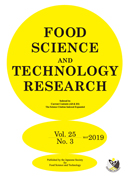Volume 25, Issue 3
Displaying 1-17 of 17 articles from this issue
- |<
- <
- 1
- >
- >|
Original papers
-
2019Volume 25Issue 3 Pages 341-350
Published: 2019
Released on J-STAGE: August 15, 2019
Download PDF (590K) Full view HTML -
2019Volume 25Issue 3 Pages 351-362
Published: 2019
Released on J-STAGE: August 15, 2019
Download PDF (1429K) Full view HTML -
2019Volume 25Issue 3 Pages 363-371
Published: 2019
Released on J-STAGE: August 15, 2019
Download PDF (2526K) Full view HTML -
2019Volume 25Issue 3 Pages 373-381
Published: 2019
Released on J-STAGE: August 15, 2019
Download PDF (1162K) Full view HTML -
2019Volume 25Issue 3 Pages 383-389
Published: 2019
Released on J-STAGE: August 15, 2019
Download PDF (749K) Full view HTML
Technical Paper
-
2019Volume 25Issue 3 Pages 391-397
Published: 2019
Released on J-STAGE: August 15, 2019
Download PDF (921K) Full view HTML -
2019Volume 25Issue 3 Pages 399-404
Published: 2019
Released on J-STAGE: August 15, 2019
Download PDF (513K) Full view HTML
Original papers
-
2019Volume 25Issue 3 Pages 405-412
Published: 2019
Released on J-STAGE: August 15, 2019
Download PDF (2554K) Full view HTML -
2019Volume 25Issue 3 Pages 413-423
Published: 2019
Released on J-STAGE: August 15, 2019
Download PDF (1252K) Full view HTML -
2019Volume 25Issue 3 Pages 425-434
Published: 2019
Released on J-STAGE: August 15, 2019
Download PDF (1264K) Full view HTML -
2019Volume 25Issue 3 Pages 435-442
Published: 2019
Released on J-STAGE: August 15, 2019
Download PDF (1232K) Full view HTML -
2019Volume 25Issue 3 Pages 443-448
Published: 2019
Released on J-STAGE: August 15, 2019
Download PDF (694K) Full view HTML -
2019Volume 25Issue 3 Pages 449-457
Published: 2019
Released on J-STAGE: August 15, 2019
Download PDF (525K) Full view HTML -
2019Volume 25Issue 3 Pages 459-466
Published: 2019
Released on J-STAGE: August 15, 2019
Download PDF (5135K) Full view HTML
Technical Paper
-
2019Volume 25Issue 3 Pages 467-477
Published: 2019
Released on J-STAGE: August 15, 2019
Download PDF (2165K) Full view HTML
Note
-
2019Volume 25Issue 3 Pages 479-484
Published: 2019
Released on J-STAGE: August 15, 2019
Download PDF (639K) Full view HTML
Erratum
-
2019Volume 25Issue 3 Pages 485-488
Published: 2019
Released on J-STAGE: August 15, 2019
Download PDF (280K)
- |<
- <
- 1
- >
- >|
